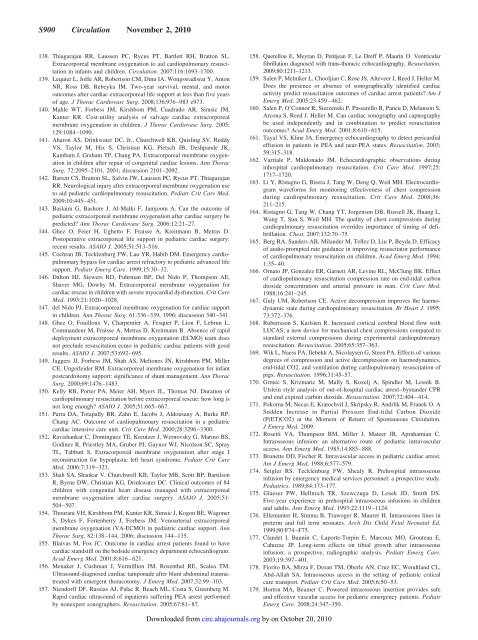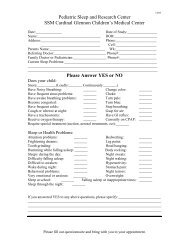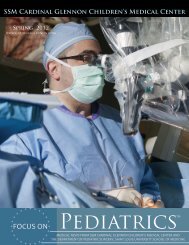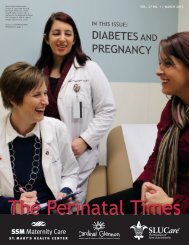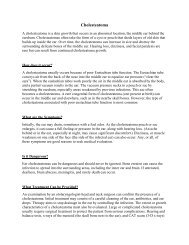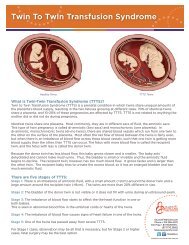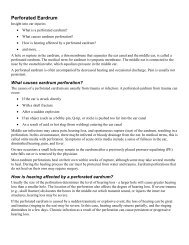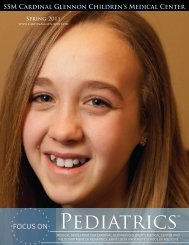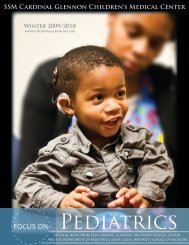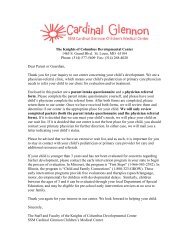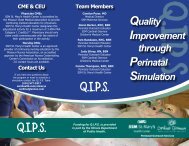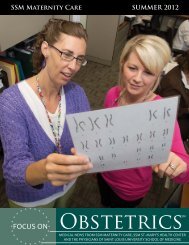pediatric-ALS-AHA-guidelines-circulation_11-2010 - SSM Cardinal ...
pediatric-ALS-AHA-guidelines-circulation_11-2010 - SSM Cardinal ...
pediatric-ALS-AHA-guidelines-circulation_11-2010 - SSM Cardinal ...
You also want an ePaper? Increase the reach of your titles
YUMPU automatically turns print PDFs into web optimized ePapers that Google loves.
S900 Circulation November 2, <strong>2010</strong>138. Thiagarajan RR, Laussen PC, Rycus PT, Bartlett RH, Bratton SL.Extracorporeal membrane oxygenation to aid cardiopulmonary resuscitationin infants and children. Circulation. 2007;<strong>11</strong>6:1693–1700.139. Lequier L, Joffe AR, Robertson CM, Dinu IA, Wongswadiwat Y, AntonNR, Ross DB, Rebeyka IM. Two-year survival, mental, and motoroutcomes after cardiac extracorporeal life support at less than five yearsof age. J Thorac Cardiovasc Surg. 2008;136:976–983 e973.140. Mahle WT, Forbess JM, Kirshbom PM, Cuadrado AR, Simsic JM,Kanter KR. Cost-utility analysis of salvage cardiac extracorporealmembrane oxygenation in children. J Thorac Cardiovasc Surg. 2005;129:1084–1090.141. Aharon AS, Drinkwater DC, Jr., Churchwell KB, Quisling SV, ReddyVS, Taylor M, Hix S, Christian KG, Pietsch JB, Deshpande JK,Kambam J, Graham TP, Chang PA. Extracorporeal membrane oxygenationin children after repair of congenital cardiac lesions. Ann ThoracSurg. 72:2095–2101, 2001; discussion 2101–2092.142. Barrett CS, Bratton SL, Salvin JW, Laussen PC, Rycus PT, ThiagarajanRR. Neurological injury after extracorporeal membrane oxygenation useto aid <strong>pediatric</strong> cardiopulmonary resuscitation. Pediatr Crit Care Med.2009;10:445–451.143. Baslaim G, Bashore J, Al-Malki F, Jamjoom A. Can the outcome of<strong>pediatric</strong> extracorporeal membrane oxygenation after cardiac surgery bepredicted? Ann Thorac Cardiovasc Surg. 2006;12:21–27.144. Ghez O, Feier H, Ughetto F, Fraisse A, Kreitmann B, Metras D.Postoperative extracorporeal life support in <strong>pediatric</strong> cardiac surgery:recent results. ASAIO J. 2005;51:513–516.145. Cochran JB, Tecklenburg FW, Lau YR, Habib DM. Emergency cardiopulmonarybypass for cardiac arrest refractory to <strong>pediatric</strong> advanced lifesupport. Pediatr Emerg Care. 1999;15:30–32.146. Dalton HJ, Siewers RD, Fuhrman BP, Del Nido P, Thompson AE,Shaver MG, Dowhy M. Extracorporeal membrane oxygenation forcardiac rescue in children with severe myocardial dysfunction. Crit CareMed. 1993;21:1020–1028.147. del Nido PJ. Extracorporeal membrane oxygenation for cardiac supportin children. Ann Thorac Surg. 61:336–339, 1996; discussion 340–341.148. Ghez O, Fouilloux V, Charpentier A, Fesquet P, Lion F, Lebrun L,Commandeur M, Fraisse A, Metras D, Kreitmann B. Absence of rapiddeployment extracorporeal membrane oxygenation (ECMO) team doesnot preclude resuscitation ecmo in <strong>pediatric</strong> cardiac patients with goodresults. ASAIO J. 2007;53:692–695.149. Jaggers JJ, Forbess JM, Shah AS, Meliones JN, Kirshbom PM, MillerCE, Ungerleider RM. Extracorporeal membrane oxygenation for infantpostcardiotomy support: significance of shunt management. Ann ThoracSurg. 2000;69:1476–1483.150. Kelly RB, Porter PA, Meier AH, Myers JL, Thomas NJ. Duration ofcardiopulmonary resuscitation before extracorporeal rescue: how long isnot long enough? ASAIO J. 2005;51:665–667.151. Parra DA, Totapally BR, Zahn E, Jacobs J, Aldousany A, Burke RP,Chang AC. Outcome of cardiopulmonary resuscitation in a <strong>pediatric</strong>cardiac intensive care unit. Crit Care Med. 2000;28:3296–3300.152. Ravishankar C, Dominguez TE, Kreutzer J, Wernovsky G, Marino BS,Godinez R, Priestley MA, Gruber PJ, Gaynor WJ, Nicolson SC, SprayTL, Tabbutt S. Extracorporeal membrane oxygenation after stage Ireconstruction for hypoplastic left heart syndrome. Pediatr Crit CareMed. 2006;7:319–323.153. Shah SA, Shankar V, Churchwell KB, Taylor MB, Scott BP, BartilsonR, Byrne DW, Christian KG, Drinkwater DC. Clinical outcomes of 84children with congenital heart disease managed with extracorporealmembrane oxygenation after cardiac surgery. ASAIO J. 2005;51:504–507.154. Thourani VH, Kirshbom PM, Kanter KR, Simsic J, Kogon BE, WagonerS, Dykes F, Fortenberry J, Forbess JM. Venoarterial extracorporealmembrane oxygenation (VA-ECMO) in <strong>pediatric</strong> cardiac support. AnnThorac Surg. 82:138–144, 2006; discussion 144–135.155. Blaivas M, Fox JC. Outcome in cardiac arrest patients found to havecardiac standstill on the bedside emergency department echocardiogram.Acad Emerg Med. 2001;8:616–621.156. Menaker J, Cushman J, Vermillion JM, Rosenthal RE, Scalea TM.Ultrasound-diagnosed cardiac tamponade after blunt abdominal traumatreatedwith emergent thoracotomy. J Emerg Med. 2007;32:99–103.157. Niendorff DF, Rassias AJ, Palac R, Beach ML, Costa S, Greenberg M.Rapid cardiac ultrasound of inpatients suffering PEA arrest performedby nonexpert sonographers. Resuscitation. 2005;67:81–87.158. Querellou E, Meyran D, Petitjean F, Le Dreff P, Maurin O. Ventricularfibrillation diagnosed with trans-thoracic echocardiography. Resuscitation.2009;80:12<strong>11</strong>–1213.159. Salen P, Melniker L, Chooljian C, Rose JS, Alteveer J, Reed J, Heller M.Does the presence or absence of sonographically identified cardiacactivity predict resuscitation outcomes of cardiac arrest patients? Am JEmerg Med. 2005;23:459–462.160. Salen P, O’Connor R, Sierzenski P, Passarello B, Pancu D, Melanson S,Arcona S, Reed J, Heller M. Can cardiac sonography and capnographybe used independently and in combination to predict resuscitationoutcomes? Acad Emerg Med. 2001;8:610–615.161. Tayal VS, Kline JA. Emergency echocardiography to detect pericardialeffusion in patients in PEA and near-PEA states. Resuscitation. 2003;59:315–318.162. Varriale P, Maldonado JM. Echocardiographic observations duringinhospital cardiopulmonary resuscitation. Crit Care Med. 1997;25:1717–1720.163. Li Y, Ristagno G, Bisera J, Tang W, Deng Q, Weil MH. Electrocardiogramwaveforms for monitoring effectiveness of chest compressionduring cardiopulmonary resuscitation. Crit Care Med. 2008;36:2<strong>11</strong>–215.164. Ristagno G, Tang W, Chang YT, Jorgenson DB, Russell JK, Huang L,Wang T, Sun S, Weil MH. The quality of chest compressions duringcardiopulmonary resuscitation overrides importance of timing of defibrillation.Chest. 2007;132:70–75.165. Berg RA, Sanders AB, Milander M, Tellez D, Liu P, Beyda D. Efficacyof audio-prompted rate guidance in improving resuscitator performanceof cardiopulmonary resuscitation on children. Acad Emerg Med. 1994;1:35–40.166. Ornato JP, Gonzalez ER, Garnett AR, Levine RL, McClung BK. Effectof cardiopulmonary resuscitation compression rate on end-tidal carbondioxide concentration and arterial pressure in man. Crit Care Med.1988;16:241–245.167. Guly UM, Robertson CE. Active decompression improves the haemodynamicstate during cardiopulmonary resuscitation. Br Heart J. 1995;73:372–376.168. Rubertsson S, Karlsten R. Increased cortical cerebral blood flow withLUCAS; a new device for mechanical chest compressions compared tostandard external compressions during experimental cardiopulmonaryresuscitation. Resuscitation. 2005;65:357–363.169. Wik L, Naess PA, Ilebekk A, Nicolaysen G, Steen PA. Effects of variousdegrees of compression and active decompression on haemodynamics,end-tidal CO2, and ventilation during cardiopulmonary resuscitation ofpigs. Resuscitation. 1996;31:45–57.170. Grmec S, Krizmaric M, Mally S, Kozelj A, Spindler M, Lesnik B.Utstein style analysis of out-of-hospital cardiac arrest–bystander CPRand end expired carbon dioxide. Resuscitation. 2007;72:404–414.171. Pokorna M, Necas E, Kratochvil J, Skripsky R, Andrlik M, Franek O. ASudden Increase in Partial Pressure End-tidal Carbon Dioxide(P(ET)CO2) at the Moment of Return of Spontaneous Circulation.J Emerg Med. 2009.172. Rosetti VA, Thompson BM, Miller J, Mateer JR, Aprahamian C.Intraosseous infusion: an alternative route of <strong>pediatric</strong> intravascularaccess. Ann Emerg Med. 1985;14:885–888.173. Brunette DD, Fischer R. Intravascular access in <strong>pediatric</strong> cardiac arrest.Am J Emerg Med. 1988;6:577–579.174. Seigler RS, Tecklenburg FW, Shealy R. Prehospital intraosseousinfusion by emergency medical services personnel: a prospective study.Pediatrics. 1989;84:173–177.175. Glaeser PW, Hellmich TR, Szewczuga D, Losek JD, Smith DS.Five-year experience in prehospital intraosseous infusions in childrenand adults. Ann Emerg Med. 1993;22:<strong>11</strong>19–<strong>11</strong>24.176. Ellemunter H, Simma B, Trawoger R, Maurer H. Intraosseous lines inpreterm and full term neonates. Arch Dis Child Fetal Neonatal Ed.1999;80:F74–F75.177. Claudet I, Baunin C, Laporte-Turpin E, Marcoux MO, Grouteau E,Cahuzac JP. Long-term effects on tibial growth after intraosseousinfusion: a prospective, radiographic analysis. Pediatr Emerg Care.2003;19:397–401.178. Fiorito BA, Mirza F, Doran TM, Oberle AN, Cruz EC, Wendtland CL,Abd-Allah SA. Intraosseous access in the setting of <strong>pediatric</strong> criticalcare transport. Pediatr Crit Care Med. 2005;6:50–53.179. Horton MA, Beamer C. Powered intraosseous insertion provides safeand effective vascular access for <strong>pediatric</strong> emergency patients. PediatrEmerg Care. 2008;24:347–350.Downloaded from circ.ahajournals.org by on October 20, <strong>2010</strong>


